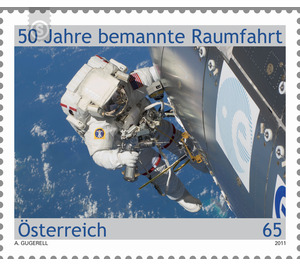50 years - Austria / II. Republic of Austria 2011 - 65 Euro Cent
Theme: Traffic, Transportation & Mobility
| Country | Austria / II. Republic of Austria |
| Issue Date | 2011 |
| Face Value | 65.00 |
| Edition Issued | 650,000 |
| Printing Type | offset |
| Stamp Type | Commemorative |
| Item Type | Stamp |
| Chronological Issue Number | 2255 |
| Chronological Chapter | OOS-OE2 |
| SID | 464855 |
| In 57 Wishlists | |
"50 years of manned spaceflight" The era of manned spaceflight, a milestone in human history, began on April 12, 1961 - a historic day that is commemorated with its own special stamp on its 50th anniversary. The issue is, according to the occasion, accordingly innovative, but was a silver foil, which ensures a special shine, applied to the brand and printed. The miniature sheet, consisting of ten stamps, the edge of which is decorated with the presentation of various famous spacecraft, in its entirety is undoubtedly a successful piece of "contemporary philately." The history of manned space flight: It was Yuri Gagarin, the legendary Russian cosmonaut who was the first human to orbit the Earth on a Vostok spacecraft on April 12, 1961. Just a few weeks later, on May 5, 1961, the US "countered" as part of its Mercury program with a 16-minute suborbital flight from Alan Shepard. In 1968 the first humans flew into space with the "Apollo 7" as part of the Apollo program, which finally resulted in the first manned moon landing in 1969 with the famous "Apollo 11" with the three astronauts Neil Armstrong, Edwin "Buzz" Aldrin and Michael Collins culminated. After that, they focused on the near-Earth space. The space stations Saljut and Skylab offered the people in space a modest "home". With the so-called "Apollo Soyuz Project" in 1975 there was also for the first time a joint US-Soviet mission. After that, the two nations parted ways for the next twenty years. Already in the seventies, the development of the US space shuttle took place. Although these are still being used after the catastrophic "Columbia" disaster, a successor system is already in the development stage. In the course of the strategic realignment of NASA at the beginning of 2004, other spacecraft will be needed for the planned lunar and meteorological flights, in addition, the future of the ISS is uncertain. The Soviet Union also relied on the shuttle concept in the 1980s - the result was the space shuttle "Buran", which was to provide the counterpart to the US Space Shuttle. However, due to financial and political difficulties, Buran was never able to complete a manned mission. In 1993, the program was finally stopped. In parallel, the Soviet Union continued to work on its manned space station program. In 1986, the first module of the space station "Mir", which remained in operation until 2001 and provided 28 regular crews, was launched. It is interesting that the International Space Station ISS forms the basis for all current activities of the state space agencies, with the exception of the People's Republic of China.


